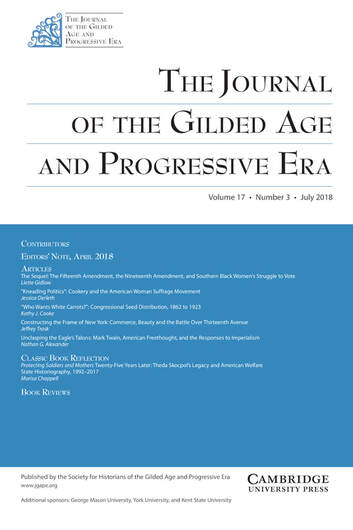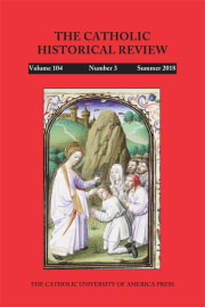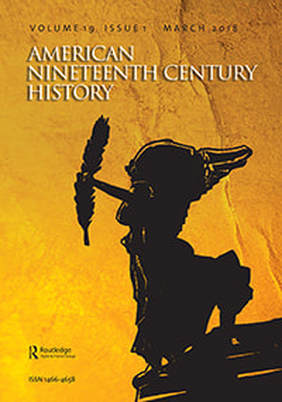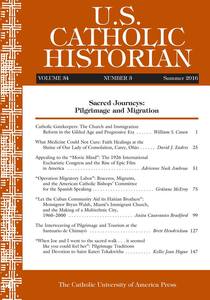"HISTORY...IS AN ENDEAVOR TOWARD BETTER UNDERSTANDING AND, CONSEQUENTLY, A THING IN MOVEMENT."
JOURNAL ARTICLES
"Catholic Women, Hidden Work, and Separate Spheres: The Columbian Catholic Congress of 1893," The Journal of the Gilded Age and Progressive Era (forthcoming, Summer 2021)
|
In September 1893, Catholic laypeople, clergy, and prelates met at the World’s Columbian Exposition in Chicago as the Columbian Catholic Congress to discuss their church’s history and chart its course into the future. The leadership of Catholic laywomen in shaping the course of the Congress has been virtually absent in scholarship, much as it was hidden from contemporaries in the past. The act of a Catholic woman speaking among both men and women in a public space was significant, as it demonstrated an increasing assertiveness on the part of Catholic women, including those holding to a conception of gendered, separate spheres, that women had key roles to play in shaping public Catholicity and Catholics’ ideas about their own community of faith. A core group of Catholic women played a hitherto underappreciated part in bringing the Congress to life. This study therefore centers women in the history of, more narrowly, Catholicism’s place at the World’s Columbian Exposition and, more broadly, the Catholic public of the early Progressive Era, and demonstrates the often-invisible labor in which women engaged to develop their church’s intellectual life in the early Progressive Era.
|
"Education in the Name of the Lord: The Rise and Decline of the Catholic Labor Schools," The Catholic Historical Review 104, no. 3 (Summer 2018): 475-498
|
This article seeks to overcome a traditional disjuncture between labor and religious history by analyzing the role of labor schools as central points of contact between the Catholic Church and workers in the mid-twentieth century. It takes as its primary subject Hartford’s Diocesan Labor Institute, which operated from 1942 to 1967. Hartford's program is of particular historical interest due to its longevity, its extensive public reach, and its role as a model for the founding of several other labor schools. I argue that gender and class shifts - particularly the increasing entry of women into the workforce and a perceived climb up the class ladder by Catholic workers - together contributed to both the rise and decline of Catholic labor education in Connecticut and the United States.
|
"Blood Honor, Reform, and God: Anti-Dueling Associations and Moral Reform in the Old South," American Nineteenth Century History 19, no. 1 (2018): 23-45
|
Scholars have written extensively on dueling and honor in the antebellum period, but most have neglected or dismissed the work of anti-dueling associations. Anti-dueling activists staked a claim to public power by challenging duelists’ claims to mastery. The history of the organizations provides evidence that the South was home to many similar societies dedicated to public activism and moral uplift. Their work illustrates the incapacity of the law, in a period of social transformation on the eve of the sectional crisis, to produce social reform without community support and the commitment of authorities to safeguard public order.
|
"Catholic Gatekeepers: The Church and Immigration Reform in the Gilded Age and Progressive Era," U.S. Catholic Historian 34, no. 3 (Summer 2016): 1-23
|
Although scholars have analyzed the second wave of European immigration following the Civil War, they have devoted less space to examining representations of the new, European, Catholic migrants by native-born American Catholics, and while the historiography of American Catholicism has been increasingly attentive to ethnic divisions within the country’s wider Catholic community, there has been little in the way of interpretations of the actual rhetoric, imagery, and ideology at the foundation of such divisions. Catholics, especially those associated with the modernist and Americanist movements within the church in the latter decades of the nineteenth century, this article argues, frequently attached their religious community to the period’s prevailing, hegemonic discourses of whiteness and Anglo-American racial superiority. The Americanist movement, in particular, may have had a darker side than has been previously acknowledged. These ideologies have been traditionally consigned to the Protestant camp when, in fact, Catholics actually played an important role in reconstructing and redeploying against their coreligionists the very rhetoric which had been used frequently in the service of anti-Catholicism
|
"Monk in the Middle: The Awful Disclosures of the Hotel Dieu Nunnery and the Making of Catholic Identity," American Catholic Studies 125, no. 1 (Spring 2014): 25-45

This article examines the controversy surrounding the publication in 1836 of Maria Monk's Awful Disclosures of the Hotel Dieu Nunnery, a sensational exposé of life in a Montreal convent that was supposedly written by a former nun. Previous scholarship on the Monk episode has focused principally on anti-Catholic nativism and on the Awful Disclosures' place in the larger genre of antebellum convent tales. This study provides a new interpretation of the controversy surrounding Monk's book by demonstrating its usefulness for historians seeking to understand how Catholics apprehended their position in the American community. Catholics frequently used the Awful Disclosures to stake a claim as authentic Americans and often inverted anti-Catholic rhetoric to suit their political and social needs. Through their response to the Monk episode, Catholic leaders effectively redeployed anti-Catholic rhetoric to undermine the claims of Monk and her supporters, ultimately forging a distinctive form of Catholic anti-Protestantism and serving with their sectarian foes as partners, perhaps unwittingly, in a common antebellum project of defining and reasserting patriarchy.
"Catholics, Constitutions, and Conventions: Bishop John England and the Democratization of American Catholicism," The South Carolina Historical Magazine 114, no. 4 (Oct. 2013): 316-340
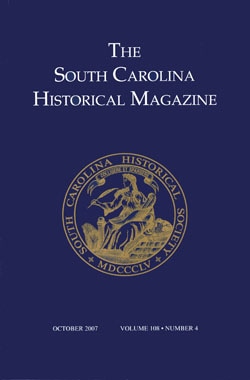
In 1820, Bishop John England arrived in the newly formed Catholic Diocese of Charleston, bringing with him from his native Ireland traditions of republicanism and clerical activism. Throughout his twenty-two year bishopric, England adapted his republicanism to the American religious context but also proved equally adept at drawing on contemporary practices of Protestant religious communities in the South to gain a foothold in an increasingly competitive religious market. Benefiting from official disestablishment and removal of most of the political disabilities that previously affected Catholics in the diocese, England instituted a series of conventions that brought together laymen and clergy who were tasked with assisting the bishop in setting the future course of the local church. While unique in antebellum American Catholicism, these conventions were remarkably similar to meetings conducted by the diocese’s Protestant counterparts in the South, demonstrating a significant degree of adaptation on the part of England’s innovative form of Catholic governance. Simultaneously, while expanding the powers of laymen and forging cooperative ties between the laity and clergy, the conventions tended to reinforce southern hierarchies of class, gender, and race by delimiting the democratizing trend of antebellum Christianity. This article places Catholicism more firmly within its largely Protestant surroundings in the South, and it also revises previous interpretations of Bishop England’s conventions as exercises in unadulterated democratization by arguing that the process of religious democratization could often lead to a retrenchment of, rather than a challenge to, existing power structures.
DIGITAL SCHOLARSHIP
- "Research Postcard: South Bend, Indiana," Contingent Magazine, September 20, 2019
- This piece recounts a research trip to the University of Notre Dame Archives to explore lived Catholicism among Civil War soldiers.
- "Women & Power in American History: Catholic Women as a Test Case," Society for U.S. Intellectual History Blog, March 25, 2018
- This essay is part of the USIH Salon on Mary Beard's 2017 book, Women & Power: A Manifesto, and it analyzes Catholic women's participation at the 1893 Columbian Catholic Congress, part of the Chicago World's Columbian Exposition, through the lens of Beard's theoretical argument.
- "Total Eclipse of the Past," Society for U.S. Intellectual History Blog, August 21, 2017
- This piece examines the politics and social and cultural impact of the cross-country eclipse of June 8, 1918.
- "Historiographic Saints," Religion in American History: A Group Blog on Religion in American Culture and History, August 2, 2017
- This essay explores the role of historians in the historical and historiographical saint-making process.
- Sections of two chapters for The American Yawp, a free and online, collaboratively built American history textbook from Stanford University Press: "Anti-Catholic Nativism in Antebellum America" for chapter 9, "Democracy in America," and "American Catholicism and Vatican II" for chapter 27, "The Sixties"
- Three-part series of guest posts from the 2017 American Historical Association Annual Meeting in Denver for John Fea's blog, The Way of Improvement Leads Home
- "Reflections on the Academic Job Search" (January 6, 2017)
- "Conservatism and the Media in Historical Perspective" (January 7, 2017)
- "Catholic History at the AHA" (January 8, 2017)
Proudly powered by Weebly
